Across the cities of Samarkand, Bukhara, Khiva, and beyond, history speaks through stone. The monuments in Uzbekistan were built by emirs, scholars, and local craftsmen whose work shaped the identity of the region. Mosques, madrassas, tombs, and towers still stand with traces of their original colour and purpose. Some reflect spiritual devotion, others political strength, but all carry stories from times when this land was a centre of trade, learning, and empire. These sites are not just reminders of the past; they remain part of the present. Many are still used, visited, and respected by those who live among them.
Top 10 Monuments In Uzbekistan To Visit On Vacation
These remarkable monuments in Uzbekistan showcase the country’s rich past through architecture, religion, and power, each one offering a unique window into centuries of history and culture.
1. Registan, Samarkand
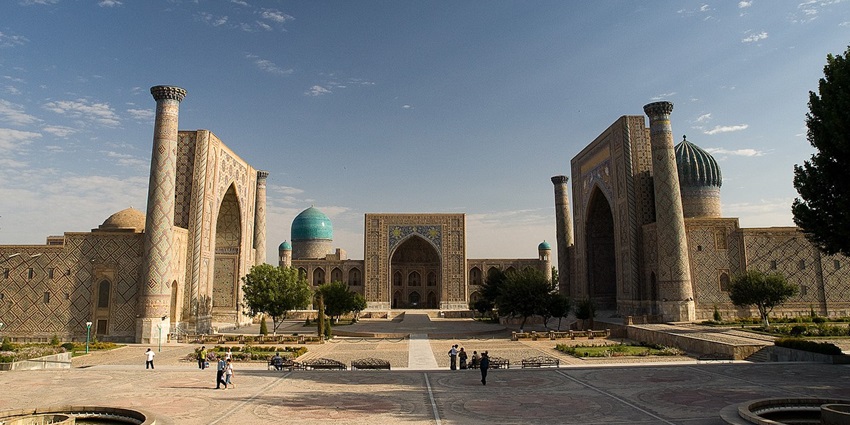
Photo: Gustavo Jeronimo / Wikimedia Commons
Registan is the monumental centre of Samarkand and once served as a public square where people gathered for royal announcements, trade, and religious festivals. It is surrounded by three large madrassas built between the 15th and 17th centuries. The Ulugh Beg Madrassa, completed in 1420, was named after the astronomer-king who led its construction. It was more than a religious school. Across from it stands the Sher-Dor Madrassa, built in the 17th century. Its façade shows tigers with sun-like faces, which is highly unusual in Islamic art. The third, Tilya-Kori Madrassa, was finished in 1660 and includes a richly decorated mosque, where the ceilings are layered with real gold leaf.
Entry Fee: 50,000 UZS / ₹ 430
Timings: 8 AM – 6 PM
2. Shah-i-Zinda, Samarkand
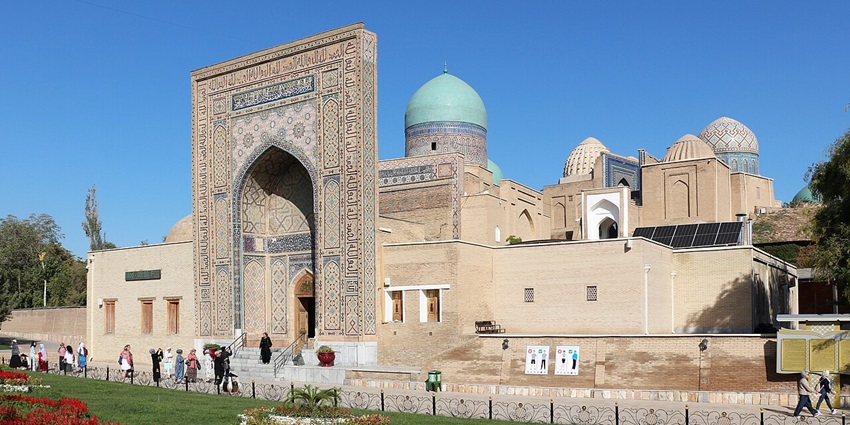
Photo: Bgag / Wikimedia Commons
Shah-i-Zinda is one of the most significant monuments in Uzbekistan, located in northern Samarkand. The site is a long, narrow pathway lined with tombs, built between the 9th and 14th centuries, with domes and portals covered in glazed tiles. It is centred around the shrine of Kusam ibn Abbas, His burial chamber is the part of the complex and continues to receive visitors. The name means “Tomb of the Living King,” based on the belief that he still lives in a hidden chamber. Each mausoleum along the corridor was built for a different royal, scholar, or noble, many connected to Timur’s dynasty.
Entry Fee: 30,000 UZS / ₹ 260
Timings: 9 AM – 5 PM
3. Kalta Minor Minaret, Khiva
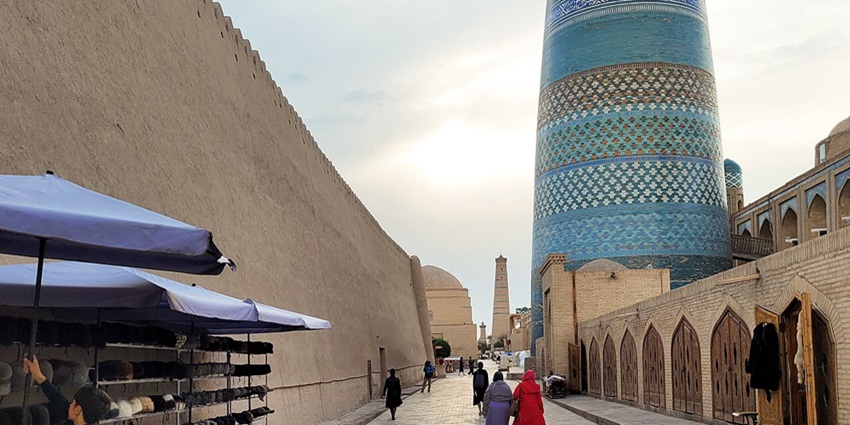
Photo: Bgag / Wikimedia Commons
Kalta Minor Minaret stands in the heart of Itchan Kala, the walled old town of Khiva. Construction began in 1851 under Muhammad Amin Khan, who intended it to be the tallest minaret in the Islamic world. However, work stopped abruptly in 1855 after the Khan’s death, leaving it unfinished. Despite this, the structure remains extraordinary today. It rises to about 29 metres but was originally planned to be over 70 metres tall. The minaret’s surface is wrapped in green and blue glazed tiles, with repeating bands of geometric design and Arabic script. Unlike most minarets that taper at the top, Kalta Minor retains its wide base all the way up, giving it a powerful, tower-like form. Because of its unusual proportions and bright decoration, it dominates Khiva’s skyline and appears even more prominent when viewed from the city walls.
Entry Fee: 62,004 UZS / ₹ 410
Timings: 8 AM – 6 PM
4. Ark Of Bukhara
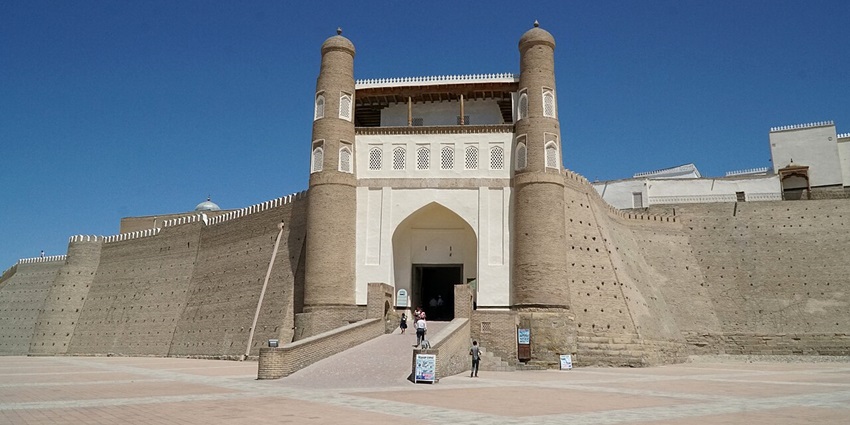
Photo: Adam Harangozó / Wikimedia Commons
The Ark of Bukhara is a large fortress that served as the political and military centre of the city for centuries. It is one of the oldest and most significant monuments in Uzbekistan, with origins going back to the 5th century. This walled complex was once a complete city, home to the emir, his court, military officers, servants, and scholars. The massive sloping walls and high entrance towers stand beside Registan Square, marking the entrance to what was once the emir’s stronghold. Inside the walls are structures including a 17th-century mosque, royal residence, reception halls, and storage rooms. The Juma Mosque inside the Ark still displays carved wooden columns and remains of painted ceilings.
Entry Fee: 40,000 UZS / ₹ 345
Timings: 9 AM – 6 PM
5. Chor Minor, Bukhara

Photo: Alexandra Kim / Wikimedia Commons
Chor Minor is a small madrasa in Bukhara known for its unusual design and peaceful atmosphere. It is among the more distinctive monuments in Uzbekistan, built in the early 1800s by Khalif Niyazkul, a wealthy Turkmen merchant. The structure’s name means “Four Minarets,” though none of the towers were used for the call to prayer. Each of the four towers is topped with a blue-tiled dome and decorated with a different pattern. These variations are said to reflect different regions of the Islamic world. The central building served as a prayer hall, and part of the original madrassa once attached to it no longer exists. Inside one of the towers is a narrow staircase that leads up to the roof, giving views over nearby homes and alleyways. The architecture does not follow the traditional style found in most Uzbek madrassas, which is what makes Chor Minor so visually striking.
Entry Fee: 10,000 UZS / ₹ 85
Timings: 9 AM – 7 PM
6. Kalyan Minaret, Bukhara
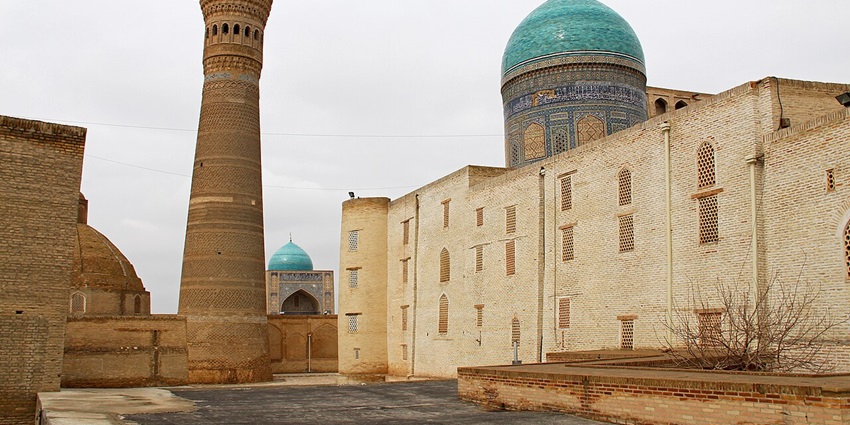
Photo: travelmag.com / Wikimedia Commons
The Kalyan Minaret is one of the most recognised monuments in Uzbekistan, towering over the old city of Bukhara. Built in 1127 under the rule of the Karakhanid dynasty, it stands at nearly 48 metres and served both religious and practical purposes. Its name means “Great Minaret,” and it was used for the call to prayer, visible from miles away across the desert. The minaret is made of baked bricks, with over a dozen different decorative bands carved directly into the surface. These patterns include floral motifs, Arabic calligraphy, and geometric shapes, all without the use of coloured tiles. The structure was strong enough to survive Genghis Khan’s invasion when many other buildings were destroyed. It later became part of the Po-i-Kalyan complex, which includes a mosque and a madrassa. Locals once referred to it as the “Tower of Death” because criminals were thrown from its top during public executions.
Entry Fee: 20,000 UZS / ₹170
Timings: 9 AM – 6 PM
7. Ayaz Kala, Karakalpakstan
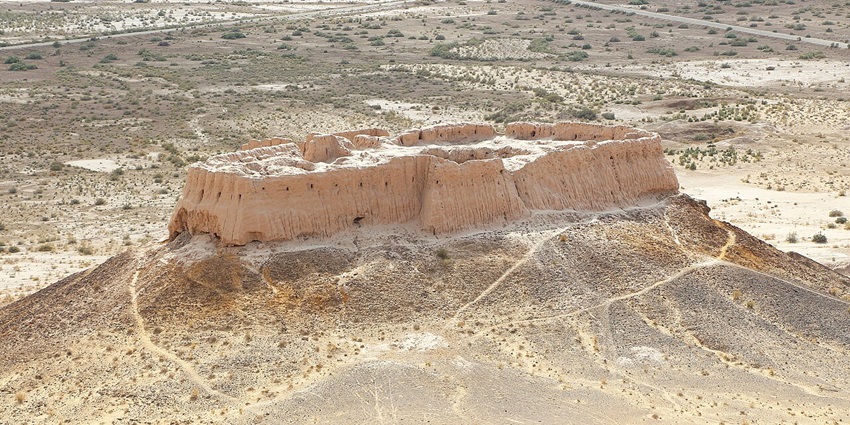
Photo: Bgag / Wikimedia Commons
Ayaz Kala is a group of ancient desert fortresses located in the autonomous region of Karakalpakstan, in northwestern Uzbekistan. These ruins are among the most isolated monuments in Uzbekistan, built between the 4th century BCE and 7th century CE during the Khorezm civilisation. The largest and best preserved is Ayaz Kala 1, set on a high hill overlooking the Kyzylkum Desert. It was likely built to defend against nomadic raids and to control trade routes across the plains. The thick mud-brick walls still stand, some reaching up to 10 metres, with watchtowers and entry points that show the layout of an advanced military structure. Nearby are Ayaz Kala 2 and 3, believed to be used for aristocratic residences and lookout posts. Visiting requires a short hike, but the views of the endless desert and silence are unforgettable.
Location: Ellikkala District, Karakalpakstan
Timings: 24*7
8. Gur-e-Amir, Samarkand
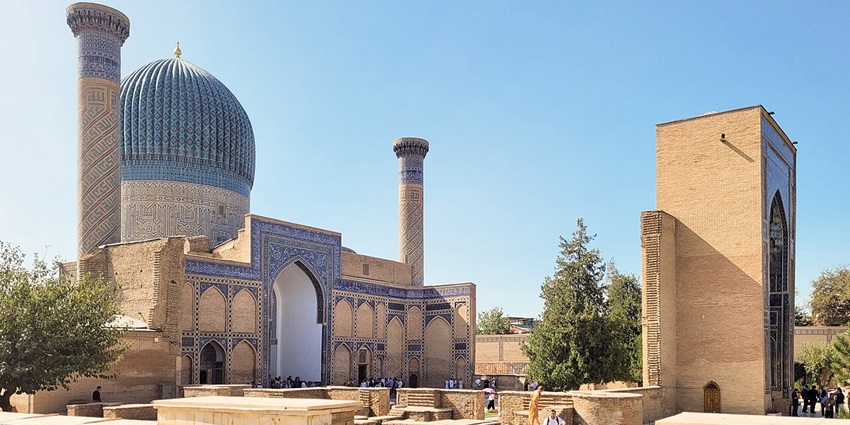
Photo: Bgag / Wikimedia Commons
Gur-e-Amir is the mausoleum of Amir Timur, the 14th-century conqueror who established the Timurid Empire. Among the most historically significant monuments in Uzbekistan, it stands in the southern part of Samarkand. Originally built in 1403 for his grandson, Muhammad Sultan, it later became the final resting place of Timur himself. The building has a tall entrance portal and a large fluted dome covered in deep blue tiles. Inside the chamber are the tomb markers of Timur, his sons and grandsons, and his spiritual mentor, Mir Sayyid Baraka. The actual burial vault lies in a crypt beneath the floor. The walls and ceilings are richly decorated with gold leaf, painted patterns, and carved stone. Gur-e-Amir’s design had a major influence on later Central Asian and Mughal tombs.
Entry Fee: 25,000 UZS / ₹ 215
Timings: 9 AM – 5 PM
9. Bibi-Khanym Mosque

Photo: David Stanley / Wikimedia Commons
Bibi-Khanym Mosque stands as one of the most impressive monuments in Uzbekistan, built at the end of the 14th century under the orders of Amir Timur. It was supposed to be the largest mosque in the Islamic world and to reflect the strength of his empire. The mosque features a monumental entrance, high minarets, and a central dome that once dominated the skyline of Samarkand. Decorative tiles in deep blue and turquoise cover much of the surface, with stone carvings and calligraphy adding detail. The marble Qur’an stand in the centre of the courtyard was placed there for public readings and remains in place. Although parts of the mosque collapsed from earthquakes and neglect over the centuries, restoration work has helped preserve the structure. Located near the busy Siab Bazaar, it sits in the centre of everyday life, offering both a view of the past and a place of quiet reflection.
Entry Fee: 30,000 UZS / ₹260
Timings: 8 AM – 6 PM
10. Ak-Saray Palace, Shahrisabz

Photo: Hassan Gangu / Wikimedia Commons
Ak-Saray Palace was built by Amir Timur as his summer residence and political centre in Shahrisabz. It remains one of the most monumental and ambitious monuments in Uzbekistan. Construction began in the 1380s and continued for more than two decades. The entrance portal still stands, rising over 38 metres, covered in glazed tiles with traces of cobalt blue, white, and gold. The inscription across the top reads, “If you doubt our power, look at our buildings.” Although the main palace buildings no longer survive, records describe vast courtyards, reception halls, and carefully planned gardens. The palace was designed to impress visiting rulers and ambassadors, showcasing the authority of Timur’s rule. Its decoration, scale, and organisation reflect the richness of that period and visitors today walk along marked paths that follow the original layout.
Entry Fee: 25,000 UZS / ₹ 215
Timings: 9 AM – 6 PM
The monuments in Uzbekistan reflect a past that shaped every corner of the country. These buildings were made for worship, rule, study, and defence, but they still stand with purpose. Some are active spaces, others are preserved in silence, yet each carries layers of memory that stretch across centuries. The craft thought, and meaning behind them remain clear in every tile, arch, and dome. Exploring them is not just travel but stepping into the story of a civilisation. Start planning your trip with TripXL to experience it firsthand.
Cover Photo: Kraftabbas / Wikimedia Commons


 WhatsApp
WhatsApp
 Twitter
Twitter









